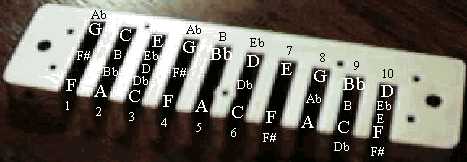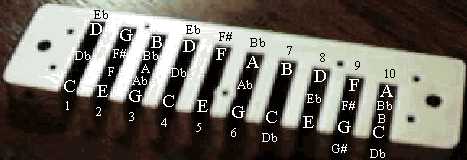Harmonica notes layout – Many beginning players are confused about harmonica notes, particularly since some of them are missing. This articles shows the notes on a harmonica, and the reasoning behind their layout.
Harmonica notes layout
Chromatic Harmonica Note Layout
NOTE POSITIONS
The purpose of this article is to cover one and only one topic: what the NOTE POSITIONS are on a 16-HOLE CHROMATIC HARMONICA.
While there are 16 holes on a 16-hole chromatic harmonica, they don’t number the holes from 1-16 on the cover of the harmonica. Instead, they number the first FOUR holes with numbers 1-4, then start over again with #1 at hole 5 and go up to #12 on the 16th hole.
Why do they do this? For many years, Chromatic Harmonicas had 12 holes, and many of the books were written explaining technique on a 12-holer.
Let’s give the 16 hole chromatic harmonica a QUICK GLANCE, before we get into detail on the notes available on each hole. Each hole has 4 reeds, so there are 64 tones total, and some are duplicates. You access those 4 notes per hole by the DRAW and the BLOW, with and without the slide in.
Pushing the slide in always raises the given note by one half tone.
THE NOTES REPEAT THE SAME PATTERN….4 TIMES
The single line chart below provides you the BLOW ONLY notes on a 16 hole chromatic. You’ll notice right away that the identical pattern of C E G C repeats itself 4 times. Because the pattern repeats every 4 holes, it makes it simpler for you to find notes.
4 NOTE PROGRESSION, BLOW ONLY
| C | E | G | C | C | E | G | C | C | E | G | C | C | E | G | C |
WHAT ARE THOSE NOTES…WHAT IS THE RANGE OF THIS INSTRUMENT?
The 16 hole chromatic harmonic has a larger range than a flute, a trumpet or a guitar, but less than a piano. Some of you have musical training, and you may be curious what the note range is on a 16-hole chromatic harmonica, in terms of a piano keyboard.
A 16 hole chromatic harmonica has a range from C3 which is the C below middle C on a piano, up to a D7. So it’s 4 octaves plus a C# and a D. That’s 4 octaves.
Harmonica’s makes sound both BLOWING and DRAWING IN AIR, these are called BLOWS and DRAWS. Here’s a complete note layout chart, I’ll explain it in detail.
Blow | C | E | G | C | C | E | G | C | C | E | G | C | C | E | G | C | |
Slide Out | Hole | 1 | 2 | 3 | 4 | 1 | 2 | 3 | 4 | 5 | 6 | 7 | 8 | 9 | 10 | 11 | 12 |
Draw | D | F | A | B | D | F | A | B | D | F | A | B | D | F | A | B | |
16 Hole Chromatic, Key of C | |||||||||||||||||
Blow | C# | E# | G# | C# | C# | E# | G# | C# | C# | E# | G# | C# | C# | E# | G# | C# | |
Slide In | Hole | 1 | 2 | 3 | 4 | 1 | 2 | 3 | 4 | 5 | 6 | 7 | 8 | 9 | 10 | 11 | 12 |
Draw | D# | F# | A# | C | D# | F# | A# | C | D# | F# | A# | C | D# | F# | A# | D | |
To read the top part of the chart above, start by reading the words, “Slide Out” which are in white letters on a black background on the second line. Next to the words “Slide Out”, you’ll see the word “HOLE” then numbers in the following sequence: 1,2,3,4,1,2,3,4,5,6,7,8,9,10,11,12. That center line of numbers tell you what hole to play on.
All the NOTE LETTER NAMES after the word BLOW are the notes you get when you blow in that numbered hole, again with the slide OUT, and down below, you get the NOTE LETTER NAMES you get on those same hole numbers when you DRAW breath in.
The chart just under this is similar, but it gives you the NOTE LETTER NAMES when the slide is pushed in. When you release the slide it moves back to its original position because it’s on a spring.
So: if you BLOW on hole #1 with the slide out, you get a C.
If you DRAW on hole #1 with the slide out, you get a D
If you BLOW on hole #1 with the SLIDE IN, you get a C# (also called a Db)
If you DRAW on hole #1 with the SLIDE IN, you get a D# (also called an Eb)
Then, if you blow on the 2nd hole with the slide out you get an E, and so on.
The chart below has the same information in another layout, with all combined into one chart.
| Hole | 1 | 2 | 3 | 4 | 5 | 6 | 7 | 8 | 9 | 10 | 11 | 12 | 13 | 14 | 15 | 16 |
| HOLE | °1 | °2 | °3 | °4 | 1 | 2 | 3 | 4 | 5 | 6 | 7 | 8 | 9 | 10 | 11 | 12 |
| Blow, Slide In | C# | F | G# | C# | C# | F | G# | C# | C# | F | G# | C# | C# | F | G# | C# |
| Blow, Slide Out | C | E | G | C | C | E | G | C | C | E | G | C | C | E | G | C |
| Draw, Slide Out | D | F | A | B | D | F | A | B | D | F | A | B | D | F | A | B |
| Draw, Slide In | D# | F# | A# | C | D# | F# | A# | C | D# | F# | A# | C | D# | F# | A# | D |
Let’s go over the harmonica’s notes ONE HOLE AT A TIME.
HOLE #1…all the way at the left of your harmonica
On hole #1, which is all the way to the left side of the harmonica (if you hold it so the slide, thing you can push it and it comes back) is on the right, and the numbers visible on the top of the harmonica’s cover, you get 4 notes:
When you BLOW you get a C.
When you DRAW you get a C# (also goes by the name Db, same tone, different name)
When you BLOW WITH THE SLIDE IN YOU GET A C#
When you DRAW WITH THE SLIDE IN YOU GET A D
BIG HINT….. WHEN YOU PUSH THE SLIDE “IN” YOU GET THE NEXT TONE ½ STEP ABOVE WHERE YOU WERE…BLOW OR DRAW, all the way up and down the harmonica!
HOLE #2…the second hole
On hole #2 you get 3 different notes, 4 total:
When you BLOW you get an E.
When you DRAW you get an F.
When you BLOW WITH THE SLIDE IN YOU GET AN F, (yep, same as the draw just above in this list)
When you DRAW WITH THE SLIDE IN YOU GET AN F#/ also called a Gb
Why did they do that? Well, it means you can play an F on a blow or draw, and that comes in handy.
HOLE #3…third hole
On hole #3 you get 4 different notes:
When you BLOW you get a G.
When you DRAW you get an A.
When you BLOW WITH THE SLIDE IN YOU GET AN G#/ also called an Ab.
When you DRAW WITH THE SLIDE IN YOU GET AN A#/ also called a Bb.
HOLE #4…fourth hole
On hole #4 you get 3 different notes, 4 total:
When you BLOW you get a C.
When you DRAW you get a B.
When you BLOW WITH THE SLIDE IN YOU GET A C#/ also called Db
When you DRAW WITH THE SLIDE IN YOU GET a C
Why did they do that? Well, it means you can play a C as a blow or a draw, and that comes in handy.
THIS IDENTICAL PATTERN is found on actual holes 5-8, 9-12, and 13-16, with the exception that the draw with slide in on hole #16 is a D…they didn’t want to repeat the C as in the other octave groupings…you might need the D for something.
So, that’s the note layout chart for a 16 hole CHROMATIC HARMONICA.
HOW TO PLAY THE NOTES
You can play each note and say the note name, all the way up and down the harmonica. Or hunt for all the C’s, then all the D’s, etc.
One way to play all the tones is to play what’s called a CHROMATIC scale with all 12 tones.
C, C#, D, D#, E, F, F#, G, G#, A, A#, B, C
Again, getting a half tone higher of any given note is easy on a chromatic harmonica…just push in the slide.
We will discuss this in another article and video, but some notes have more than one name, and are called ENHARMONIC.
C#/Db are the same tone, D#/Eb are the same tone, E#/F are the same tone, F#/Gb are the same tone, A#/Bb are the same tone, and B#/C are the same tone.
If you look at a piano keyboard and have someone give you the note names this will make sense, because those shared notes share the same physicial piano key.
That’s the 16 HOLE CHROMATIC HARMONICA note layout.
Diatonic Harmonica Note Layout
Here are pictures of a harp comb that shows where the notes are in a C and an F diatonic harmonica.
The holes are numbered 1-10, and the position of the hole number indicates the low note in each hole. The blow notes are shown in the hole chambers toward the front edge of the comb, and the draw notes are shown at the rear of the chambers. The notes in between the blow and draw notes in the chambers are the normal bent notes available in each hole. The notes shown outside the chambers are the overbends, consisting of overblows in holes 1-6 and overdraws in holes 7-10. Note that overbends are available in all holes, but only those that add unique notes have been shown.
The discontinuous line of hole numbers is shown to emphasize the point that the note relationships invert at hole 7. That is, on holes 1-6 the blow notes are lower than the draw notes–but on holes 7-10 the draw notes are lower than the blow notes.
Here are pictures of a harp comb that shows where the notes are in a C and an F diatonic harmonica.
The holes are numbered 1-10, and the position of the hole number indicates the low note in each hole. The blow notes are shown in the hole chambers toward the front edge of the comb, and the draw notes are shown at the rear of the chambers. The notes in between the blow and draw notes in the chambers are the normal bent notes available in each hole. The notes shown outside the chambers are the overbends, consisting of overblows in holes 1-6 and overdraws in holes 7-10. Note that overbends are available in all holes, but only those that add unique notes have been shown.
The discontinuous line of hole numbers is shown to emphasize the point that the note relationships invert at hole 7. That is, on holes 1-6 the blow notes are lower than the draw notes–but on holes 7-10 the draw notes are lower than the blow notes.

C Diatonic Note Layout
Most players who advance beyond the beginner level play in 2nd position 80%-95% of the time. (Playing in 2nd position means the tonic note is the 2 draw, which is a 5th higher than the key of the harmonica.) So, to think in the generic key of C when playing in 2nd position, you use the key of F harmonica. Here is the note layout of a key of F harmonica.

F Diatonic Note Layout
Another nice thing to see explicitly, instead of digging it out of other charts, is how to play the same note at different places on the harp. The range of a 10 hole diatonic is 3 octaves, so I’ve divided the table into Low, Mid, and Hi to correspond to these octaves.
| F Harp Note Location | |||||||||||||||||||||||||||||||||||||||||||||||||||||||||||||||||||||||||||||||||||||||||||||||||||||||||
|
|
These next tables show the holes, blow and draw, and the a*sociated notes on C and F harps.
| F Harp Notes by Hole | |||||||||||||||||||||||||||||||||||||||||||||||||||||||||||||||||||
|
|
Added by
Harmonica Tabs
WRITE A COMMENT
WRITE A COMMENT


 (6 votes, average: 4.33 out of 5)
(6 votes, average: 4.33 out of 5)




4 Comments